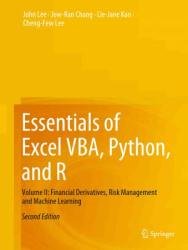 Название: Essentials of Excel VBA, Python, and R: Volume II: Financial Derivatives, Risk Management and Machine Learning, 2nd edition
Название: Essentials of Excel VBA, Python, and R: Volume II: Financial Derivatives, Risk Management and Machine Learning, 2nd editionАвтор: John Lee, Jow-Ran Chang, Lie-Jane Kao
Издательство: Springer
Год: 2023
Страниц: 521
Язык: английский
Формат: pdf (true)
Размер: 36.4 MB
This advanced textbook for business statistics teaches, statistical analyses and research methods utilizing business case studies and financial data with the applications of Excel VBA, Python and R. Each chapter engages the reader with sample data drawn from individual stocks, stock indices, options, and futures. Now in its second edition, it has been expanded into two volumes, each of which is devoted to specific parts of the business analytics curriculum. To reflect the current age of Data Science and Machine Learning, the used applications have been updated from Minitab and SAS to Python and R, so that readers will be better prepared for the current industry.
This second volume is designed for advanced courses in financial derivatives, risk management, and Machine Learning and financial management. In this volume we extensively use Excel, Python, and R to analyze the above-mentioned topics. It is also a comprehensive reference for active statistical finance scholars and business analysts who are looking to upgrade their toolkits. Readers can look to the first volume for dedicated content on financial statistics, and portfolio analysis.
Part I of this volume discusses advanced applications of Microsoft Excel Programs. Chapter 2 introduces Excel programming, Chap. 3 introduces VBA programming, and Chap. 4 discusses professional techniques used in Excel and Excel VBA techniques.
There are six chapters in Part II. Chapter 5 discusses the decision tree approach for the binomial option pricing model, Chap. 6 discusses the Microsoft Excel approach to estimating alternative option pricing models, Chap. 7 discusses how to use Excel to estimate implied variance, Chap. 8 discusses Greek letters and portfolio insurance, Chap. 9 discusses portfolio analysis and option strategies, and Chap. 10 discusses simulation and its application.
There are six chapters in Part III, which describe applications of Python, Machine Learning for financial analysis, and risk management. These six chapters are Linear Models for Regression (Chap. 11), Kernel Linear Model (Chap. 12), Neural Networks and Deep Learning (Chap. 13), Applications of Alternative Machine Learning Methods for Credit Card Default Forecasting (Chap. 14), An Application of Deep Neural Networks for Predicting Credit Card Delinquencies (Chap. 15), and Binomial/Trinomial Tree Option Pricing Using Python (Chap. 16). Part IV shows how Excel can be used to perform financial management. Chapter 17 shows ow Excel can be used to perform financial ratio analysis, Chap. 18 shows how Excel can be used to perform time value money analysis, Chap. 19 shows how Excel can be used to perform capital budgeting under certainty and uncertainty, and Chap. 20 shows how Excel can be used for financial planning and forecasting. Finally, Part V discusses applications of R programs for financial analysis and derivatives. Chapter 21 discusses the theory and application of hedge ratios. In this chapter, we show how the R program can be used for hedge ratios in terms of three econometric methods. Chapter 22 discusses applications of a simultaneous equation in finance research in terms of the R program. Finally, Chap. 23 discusses how to use the R program to estimate the binomial option pricing model and the Black and Scholes option pricing model.
In this volume, Chap. 14 was contributed by Huei-Wen Teng and Michael Lee. Chapter 15 was contributed by Ting Sun, and Chap. 22 was contributed by Fu-Lai Lin.
There are two possible applications of this volume:
A. to supplement financial derivative and risk management courses.
B. to teach students how to use Excel VBA, Python, and R to analyze financial derivatives and perform risk management.
Скачать Essentials of Excel VBA, Python, and R: Volume II: Financial Derivatives, Risk Management and Machine Learning, 2nd edition